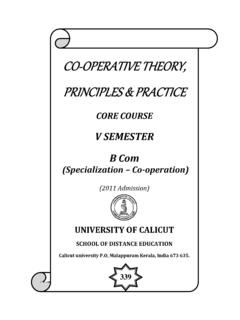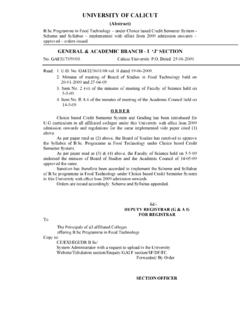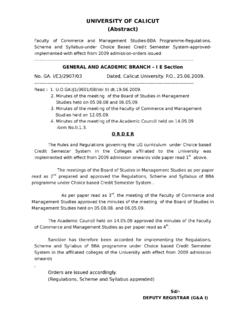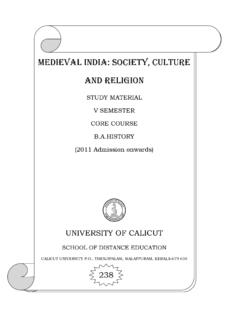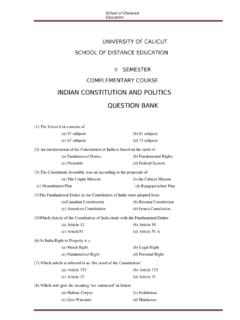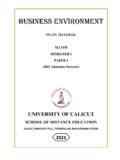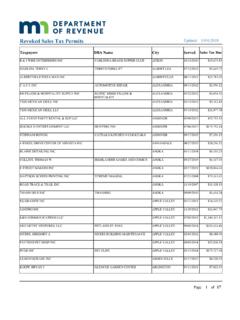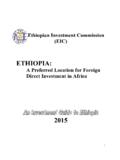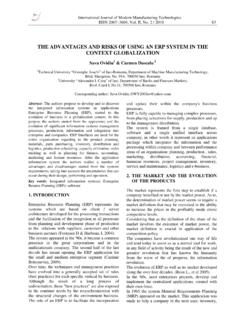Transcription of UNIVERSITY OF CALICUT
1 Study material CORE COURSE (I) For I SEMESTER BA ECONOMICS (2011 Admission) UNIVERSITY OF CALICUT SCHOOL OF DISTANCE EDUCATION CALICUT UNIVERSITY MALAPPURAM, KERALA, INDIA - 673 635 261 School of Distance Education Micro Economics - I (I Sem. BA Economics) 2 UNIVERSITY OF CALICUT SCHOOL OF DISTANCE EDUCATION Study material CORE COURSE (I) For I SEMESTER BA ECONOMICS MICRO ECONOMICS I Prepared by 1. Module I and V : Dr. P. CHACKO JOSE Associate professor, Department of Economics, Secred Heart College Chalakkudy 2. Module II : Dr. K. RAJAN Associate Professor, College, Pazhanji., Thrissur-680 542. 3. Module III : Sri. SHABEER Assistant Professor, Government College, Kodanchery. 4. Module IV : Dr.
2 ABDULLA Associate Professor, College, Kondotty. Edited & Scrutinised by : Associate Professor, Department of Economics, Govt. College, Kodanchery Reserved School of Distance Education Micro Economics - I (I Sem. BA Economics) 3 CONTENTS MODULES CONTENT PAGE No: 1 INTRODUCTION TO SOCIAL SCIENCES 5 2 INTRODUCTION TO MICRO ECONOMIC THEORY 30 3 BASIC DEMAND AND SUPPLY ANALYSIS 53 4 THE CONSUMER BEHAVIOUR AND DEMAND 94 5 PRODUCTION, COST AND REVENUE 132 School of Distance Education Micro Economics - I (I Sem. BA Economics) 4 School of Distance Education Micro Economics - I (I Sem. BA Economics) 5 Module -I Introduction to Social Sciences What are social sciences? Introduction The social sciences are one of three divisions of science, along with natural science and formal science.
3 Social science is, in its broadest sense, the study of society and the manner in which people behave and influence the world around us. The social sciences are a group of academic disciplines that study the human aspects of the world. They diverge from the arts and humanities in that the social sciences emphasize the use of the scientific method and rigorous standards of evidence in the study of humanity, including quantitative and qualitative methods. The social sciences are also known pejoratively as the soft sciences in contrast to the hard sciences. Social science theories typically deal with aggregated, not individual, behaviour. Social science investigations examine an individual s relationship with and interaction in society. Social science -cultural definition The study of people living together in groups, families, etc.
4 , and their customs, activities, etc. The study of how groups of people behave, often in an effort to predict how they will behave in the future. A branch of science that deals with the institutions and functioning of human society and with the interpersonal relationships of individuals as members of society A science (as economics or political science) dealing with a particular phase or aspect of human society Academic Definition The social sciences are a group of academic disciplines that study human aspects of the world. They diverge from the arts and humanities in that the social sciences tend to emphasize the use of the scientific method in the study of humanity, including quantitative and qualitative methods. The social sciences, in studying subjective, inter-subjective and objective or structural aspects of society, are sometimes referred to as soft sciences.
5 This is in contrast to hard sciences, which may focus exclusively on objective aspects of nature. Social scientists engage in research and theorize about both group and individual behaviours. History of Social Sciences Let us see a chronological time line of the history of social sciences. Ancient Greece In ancient philosophy, there was no difference between mathematics and the study of history, poetry or politics. Only with the development of mathematical proof did there gradually arise a perceived difference between scientific disciplines and others, the humanities or the liberal arts. Thus, Aristotle studies planetary motion and poetry with the same methods, and Plato mixes geometrical proofs with his demonstration on the state of intrinsic knowledge. School of Distance Education Micro Economics - I (I Sem.)
6 BA Economics) 6 The Enlightenment This unity of science as descriptive remains, for example, in the time of Thomas Hobbes who argued that deductive reasoning from axioms created a scientific framework, and hence his Leviathan was a scientific description of a political commonwealth. What would happen within decades of his work was a revolution in what constituted science , particularly the work of Isaac Newton in physics. Newton, by revolutionizing what was then called natural philosophy , changed the basic framework by which individuals understood what was scientific . While he was merely the archetype of an accelerating trend, the important distinction is that for Newton, the mathematical flowed from a presumed reality independent of the observer, and working by its own rules. For philosophers of the same period, mathematical expression of philosophical ideals was taken to be symbolic of natural human relationships as well: the same laws moved physical and spiritual reality.
7 For examples see Blaise Pascal, Gottfried Leibniz and Johannes Kepler, each of whom took mathematical examples as models for human behavior directly. In Pascal's case, the famous wager; for Leibniz , the invention of binary computation; and for Kepler, the intervention of angels to guide the planets. In the realm of other disciplines, this created a pressure to express ideas in the form of mathematical relationships. Such relationships, called Laws after the usage of the time (see philosophy of science) became the model which other disciplines would emulate. 19th Century Auguste Comte (1797-1857) argued that ideas pass through three rising stages, Theological, Philosophical and Scientific. He defined the difference as the first being rooted in assumption, the second in critical thinking, and the third in positive observation.
8 This framework, still rejected by many, encapsulates the thinking which was to push economic study from being a descriptive to a mathematically based discipline. Karl Marx was one of the first writers to claim that his methods of research represented a scientific view of history in this model. With the late 19th century, attempts to apply equations to statements about human behaviour became increasingly common. Among the first were the Laws of philology, which attempted to map the change over time of sounds in a language. It was with the work of Darwin that the descriptive version of social theory received another shock. Biology had, seemingly, resisted mathematical study, and yet the Theory of Natural Selection and the implied idea of Genetic inheritance - later found to have been enunciated by Gregor Mendel, seemed to point in the direction of a scientific biology based, like physics and chemistry, on mathematical relationships.
9 20th Century In the first half of the twentieth century, statistics became a free-standing discipline of applied mathematics. Statistical methods were used confidently, for example in an increasingly statistical view of biology. The first thinkers to attempt to combine inquiry of the type they saw in Darwin with exploration of human relationships, which, evolutionary theory implied, would be based on selective forces, were Freud in Austria and William James in the United States. Freud's theory of the functioning of the mind, and James' work on experimental psychology would have enormous impact on those that followed. Freud, in particular, created a framework which would appeal not only to those studying psychology, but artists and writers as well. School of Distance Education Micro Economics - I (I Sem.)
10 BA Economics) 7 One of the most persuasive advocates for the view of scientific treatment of philosophy would be John Dewey (1859-1952). He began, as Marx did, in an attempt to weld Hegelian idealism and logic to experimental science, for example in his Psychology of 1887. However, it is when he abandoned Hegelian constructs, and joined the movement in America called Pragmatism, possibly under the influence of William James' Principles of Psychology that he began to formulate his basic doctrine, enunciated in essays such as The Influence of Darwin on Philosophy (1910). This idea, based on his theory of how organisms respond, states that there are three phases to the process of inquiry: 1. Problematic Situation, where the typical response is inadequate. 2. Isolation of Data or subject matter.
